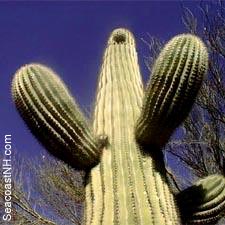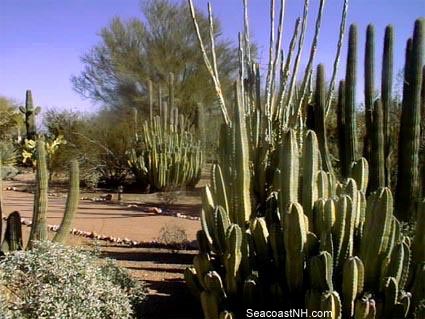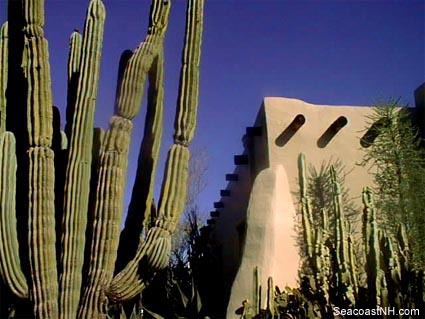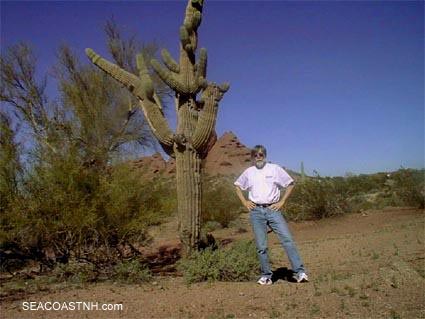| A Yankee in the Desert |

AMONG THE LCOAL CACTI
The editor, who doesn’t get out much, finds himself on a Phoenix city bus heading toward the desert. His mission is to meet his first ancient saguaro cactus. In the end, he meets hundreds, but your first cactus, they say, is always the best. The two part tour begins here (Click above)
JUMP TO Part Two
"You want to get off where, mister?"
The driver in the brown uniform and cap shouted loudly enough for everyone in the downtown Phoenix bus to hear.
"The desert," I repeated quietly. "I've never actually seen one before."
"Ain't never seen no desert?" she repeated, checking as if to be sure I hadn't stepped from a passing UFO. She pulled the chrome lever and the door hissed closed. The driver bounced on her air cushioned metal throne as she pulled back onto Washington Street. "Honey, where you from?"
"New Hampshire," I said, and it came out sounding foreign, like "Nahannana". The driver searched her memory for some connection. "It's in New England," I added. Flat stucco shops and imported palm trees whizzed by the murky bus windows.
"That anywhere near Philly?" she asked, and I nodded. Better off, when three hours from the Mexican border, to say you're from "The East."
A bus is a bus is a bus, Shakespeare rightly pointed out, and a bus by any name never smells sweet. The concierge at the Crowne Hotel had recommended I take a taxi to Papago Park at the edge of the city, not far from the zoo and the botanical desert garden. "Not far" is a term used by locals who drive cars, and it has no clear meaning for a tourist on foot.
"Are there cactus there?" I asked.
It had to sound as stupid as a Portsmouth tourist asking if he might see any boats or waves when he got to the ocean. But these guys are trained professionals.

Yankee in the Desert, Part 1
NH Tourist in Phoneix, AZ (continued)

"I believe you will see quite a number of them, sir," the concierge said without even a smirk. He slipped me the phone number of his favorite cab driver. I should call the taxi on my cell phone, he said, whenever I wanted to return from the desert. The fare would certainly be less than thirty dollars each way. For a hundred bucks, some guy in a pink jeep would buzz me around the Camelback Mountains, he suggested, but I should be wary of getting mugged by delinquent teens along the trail. I don't carry a cell phone or a very large wallet. Better, it seemed, to strike out on my own.
"That's a buck-twenty-five, Sugar," the bus driver said pointing at the automated coin counter. I dropped in five quarters, gleefully calculating the cab fare I was saving, then sat near the center of the rattling bus. I was footloose in outlaw territory and up to no good.
The cowboy sitting to my left kept a tight rein on his canvas dufflebag, stuffed taut with either a human body or the motherlode of dirty laundry. He chatted amiably to a black man with shock white hair. Two Native American teens sat silently near a man with a shaved head, muscular tattoos sprouting from both sides of his T-shirt like arms. Eventually the cowboy pulled the wire signaling the driver to stop. As he dragged his bag from the bus, a young Mexican couple with two tiny girls in frilly pink and blue dresses took his place. They chattered in animated Spanish, something about Pokeyman. Two dark-skinned teenage girls in skimpy neon outfits followed. The New Hampshire winter I left behind seemed especially colorless.
"The desert!" the driver shouted back to nobody but me soon after the last of the buildings on the outskirts of Phoenix had disappeared. Ten seconds later I was looking at pretty much nothing, cut by a divided highway and ringed with sandstone mounds. My first thought, after taking in the flatness of it all, was how similar it seemed to the ocean. My second thought was how dumb I had been to bring only a half bottle of water and a single protein bar.
With its great green arms held high, the giant saguaro cactus, iconographically speaking, is to southwestern Arizona, what seagulls and lighthouses are to seacoast, New England. It is depicted everywhere, often silhouetted against an azure sunset, or wearing a hat and saying something in a cartoon balloon. Besides a few glimpses along the highway from the airport to the city, I had seen only a few saguaros, and none up close. None were in sight as the bus hissed its way off toward the zoo and the botanical gardens that lay somewhere hidden in the flatness to my right.
I had expected sand. Fifty years of watching cowboy movies shot in the Arizona desert should have taught me otherwise. But in my mind, having never crossed the Mason-Dixon line before, all deserts were made of low rolling dunes, similar to those at Plum Island, or Ogunquit, but without the ocean, populated only by cacti, tumbleweeds, prairie dogs, scorpions and diamond back rattlers. When you don't get out much, the world is a simple place.

Yankee in the Desert, Part 1
NH Tourist in Phoneix, AZ (continued)

My first New Hampshire footstep made no impression on the mighty desert. The hard dry desert surface felt as fake as a plaster movie set and even the low shrubbery seemed no more lively than the little trees sprinkled on an HO railroad set. The only tracks in evidence were the worn trails of motocross bikes and recreational vehicles. The only scorpions I saw, in the end, were those frozen in blocks of clear Lucite and sold as keychains at the airport. The only wildlife, save for what sounded like the flutter of a jackrabbit and the occasional circling bird, were those on the Discovery Channel in the hotel. But dead ahead was what I had really come for, the shape that told me I was far, far from home.
Instinctively, with no other destination in sight, I had been walking toward the rocky red hills, ignoring a small paved road until it obligingly disappeared. Finally, there it was in all its moldy green splendor, attended by a retinue of wispy shrubs. Experts will tell you they have no idea how old the saguaros grow. They survive only in Arizona, and natives say they are hundreds of years old, older certainly than any structure in Phoenix, older perhaps than early Spanish missions, though young compared to the ruined homes of early Arizona natives.
Your first saguaro is always your best. We stood alone together for ten minutes or so, saying nothing. Maybe this guy was a round fuzzy ball on this very spot when my ancestor stepped off the Mayflower. Probably not, but there was an ancient spirit here all the same. I put my hand between the spines and touched the corrugated flesh. This green guy has been standing here motionless, I told myself, through countless 120-degree summers and ferocious desert winds. He knows how to survive. Saguaros can live years with the water they store inside. They waste no energy. They make few friends. They listen well. These were lessons worth traveling thousands of miles to learn. Checking to be sure we were alone, I positioned my camera on a desert rock, set the timer, and posed beside a large wise plant.
To make a long story short, I managed to get as lost in the desert as I regularly do in the woods and along the rivers of my home turf. It was four hours and probably five or six miles of wandering later that I found the botanical garden museum hidden right out in the open. It had looked so easy to reach when I spotted it with binoculars from atop some rocky hill. But one saguaro looks pretty much like the next, and the horizon has a tricky way of hiding the obvious out there in the Sonoran Desert. Eventually I met thousands of cacti from every imaginable tribe -- century plants, Joshua trees, monkey tails, yuccas, barrel, organ-pipe and jumping cactus. They whispered secrets of America's ancient past, things a mere Yankee could not understand.
(To Be Continued )
